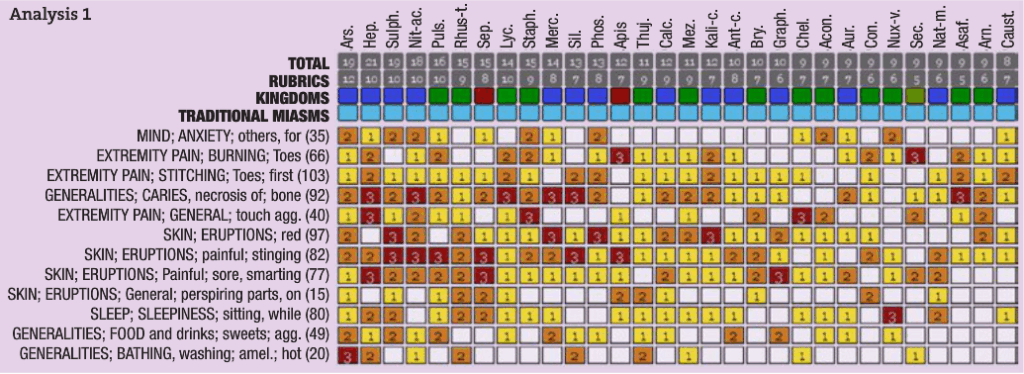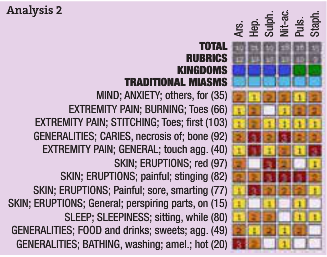Joseph Kellerstein, DC, ND
Jessica is a bright and efficient 51-year-old assistant to a local medical professional. Just over a month ago, she presented with an unusual problem.
Her great toe had been chronically inflamed and very painful. She said it had been variously diagnosed as possible cellulitis or osteomyelitis and has been bothersome since early September of 2011. No etiology could be ascertained.
Certainly, the workups have been thorough. She has had computed axial tomography scan, bone scans, magnetic resonance imaging, and gallium scans. Prescriptions have been equally generous, including numerous different antibiotics orally and for several months via peripherally inserted central catheter and pumps. She was rude enough to decline the offer of narcotics. No results emerged from any of it (I wonder about reflex sympathetic dystrophy).
She also tells me that for about 1 year there has been a chronic blotchiness of the chest between the breasts. She has a medical history of kidney stones, boils (long ago), and bronchitis. In 1972, she underwent cauterization of veins in the nose because of prolonged (>2 months) nosebleeds. Her familial history includes asthma, cancer, depression, heart disease, pneumonia, and tuberculosis.

Presenting Symptoms
When asked about her presenting symptoms, Jessica replied: “The pain in the big toe is as if I were stabbed by scissors. There is also a sensation inside the bone of burning, as if acid were burning.”
The toe is very sensitive to touch. The wearing of shoes can be a troublesome issue.
Jessica is very cold sensitive: “A fur coat is the only thing I am not cold in.”
On examination, the toe was inflamed, reddish, and somewhat swollen but not visually striking in any way. The sensitivity to touch was confirmed on examination. She was very tentative about my approach: “I had a horrible mother. Abusive. I did not deserve the abuse. When I was beaten as a child, I soon learned to take it without crying, or I got more. My energy is bad, especially in the evening.”
In general, she is a person who is nervous for the welfare of people in her world. There is a sensitivity to or aggravation from the consumption of sweets. Jessica loves hot bathing, and it lifts her feelings of well-being.
Now, in this totality the core of the most compelling symptoms was the burning and affectation of bone and the sensitivity to touch. Limiting the repertory chart to this selection looks like this:

I felt that Hepar with the coldness and Staphysagria with the sensitivity to touch were both well indicated. With the history of abuse, Staphysagria became more prominent. I prescribed Staphysagria 200 as needed.
Two Weeks Later and Beyond
At her return visit 2 weeks later, Jessica reported: “The outside of the toe and the sensitivity are 80% better! Still, some footwear is an issue. In terms of the inside, there is definitely less, but still there are times of severe pains.” Her energy is much improved.
There had been an eruption on the left medial leg (that I did not know about), which was kind of a blister and has shrunk. I recommended we continue with the remedy about twice weekly or as often as needed to maintain a sense of improvement.
Well, just yesterday one of my other patients met her at work, and Jessica was very happy with the virtual disappearance of the problem (1 month after this last follow-up visit).
Nice. It sure beats more antibiotic treatments, with the potential for complications. However, I cannot be sure of the long-term efficacy of my treatment because of the brief time of treatment.
It kind of raises some issues around our profession. For the past several years, we have seen a trend among our graduates (I assume owing to educational trends) about the primacy of the “protocol.”
At the same time, the energy and holistic approaches (especially homeopathy) at some of our schools have been (to say the least) given the backseat to “evidence-based green allopathic” approaches. They do not work as well as Hahnemannian homeopathy and “real naturopathy.”
Now, of course, our graduates are salivating over the thought of getting prescribing rights. This in turn will further dilute naturopathic education with needs of pharmacologic education.
Why do we want to be second-rate MDs when we have not yet learned to be first-rate NDs?
 Joseph Kellerstein, DC, ND graduated as a chiropractor in 1980 and as an ND in 1984. He graduated with a specialty in homeopathy from the Canadian Academy for Homeopathy, and subsequently lectured there for two years. He also lectured in homeopathy for several years at CCNM; for eight years at the Toronto School of Homeopathic Medicine; and for two years at the British Institute for Homeopathy. Dr Kellerstein’s mission is the exploration of natural medicine in a holistic context, especially homeopathy and facilitating the experience of healing in patients.
Joseph Kellerstein, DC, ND graduated as a chiropractor in 1980 and as an ND in 1984. He graduated with a specialty in homeopathy from the Canadian Academy for Homeopathy, and subsequently lectured there for two years. He also lectured in homeopathy for several years at CCNM; for eight years at the Toronto School of Homeopathic Medicine; and for two years at the British Institute for Homeopathy. Dr Kellerstein’s mission is the exploration of natural medicine in a holistic context, especially homeopathy and facilitating the experience of healing in patients.

